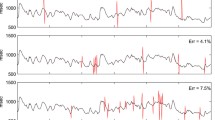Abstract
A technique based on the Hilbert–Huang transform is considered with a view to improving the heart rate variability assessment. RR intervals of circadian rhythm pre-processed by the interpolation and resampling method are investigated. Empirical modes in heart rate are detected with the help of successive operations. These modes have shown that there is an additional modulatory effect on heart rate.
Similar content being viewed by others
References
D. S. Goldstein, O. Bentho, M. Y. Park, and Y. Sharabi, “Low-frequency power of heart rate variability is not a measure of cardiac sympathetic tone but may be a measure of modulation of cardiac autonomic outflows by baroreflexes,” Exp. Physiol., 96, No, 12, 1255–1261 (2011).
A. Stankus, E. Bovina, and J. Brošaitienė, “Expression of baroreflectoric component in heart rate autospectrum,” in: Proc. Intern. Conf. on Biomedical Engineering, Kaunas Technol. Univ., Kaunas (2004), pp. 185–187.
M. Malik, “Heart rate variability: Standards of measurement, physiological interpretation, and clinical use,” Eur. Heart J., 17, 354–381 (1996).
N. E. Huang, Z. Shen, S. Long, et al., “The empirical mode decomposition and the Hilbert spectrum for nonlinear and non-stationary time series analysis,” in: Proc. of the Royal Soc. of London, Ser. A, 454, 903–995 (1998).
N. E. Huang and Z. Wu, “A review on Hilbert–Huang transform: Method and its applications to geophysical studies,” Reviews of Geophysics, 46, No. 2 (2008).
H. Li, S. Kwong, L. Yang, et al., “Hilbert–Huang transform for analysis of heart rate variability in cardiac health,” IEEE/ACM Trans. Comput. Biol. Bioinform., 8, No. 6, 1557–1567 (2011).
J. C. Echeverria, J. A. Crowe, M. S. Woolfson, and B. R. Hayes-Gill, “Application of empirical mode decomposition to heart rate variability analysis,” Med. Biol. Eng. Comput., 39, No. 4, 471–479 (2001).
E. P. de Souza Neto, P. Abry, P. Loiseau, et al., “Empirical mode decomposition to assess cardiovascular autonomic control in rats,” Fundam. Clin. Pharm., 21, No. 5, 481–496 (2007)
M. V. Kamath and E. L. Fallen, “Power spectral analysis of HRV: A noninvasive signature of cardiac autonomic functions,” Crit. Rev. Biomed. Eng., 21, 245–311 (1993).
Author information
Authors and Affiliations
Corresponding authors
Additional information
This study was partially supported by European Social Fund Agency grants for national projects “Lithuanian maritime and environmental technology research development” (No. VP1-3.1-MES-08-K-01-019), partially financed by the Research Council of the Lithuania project No. TAP-LU-02/2012 and by a European Social Fund Agency grant for the national project “Lithuanian Maritime Sector’s Technologies and Environmental Research Development” (No. VP1-3.1-ŠMM-08-K-01-019),” and partially financed by the State Agency on Science, Innovations and Informatization of Ukraine within the framework of the Program of Ukrainian-Lithuanian Scientific and Technological Cooperation (No. M/326-2013, Gov. Reg. No. 0113U005547).
Translated from Kibernetika i Sistemnyi Analiz, No. 2, pp. 153–160, March–April, 2014.
Rights and permissions
About this article
Cite this article
Stankus, A., Stankus, V., Kyselova, O.G. et al. Frequency Bands Selection Based on 24-Hour Heart Rate Using Hilbert–Huang Transform. Cybern Syst Anal 50, 297–303 (2014). https://doi.org/10.1007/s10559-014-9617-5
Received:
Published:
Issue Date:
DOI: https://doi.org/10.1007/s10559-014-9617-5




